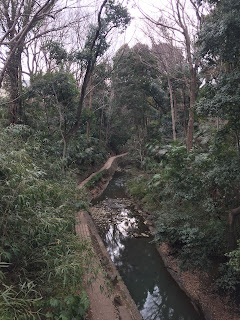When I think of quiet, meandering rivers, lush vegetation, and little sound other than your own footsteps and the chirping of various hidden birds Tokyo usually isn't the first place comes to mind. That's what makes the Todoroki Ravine a bit of a hidden gem as well as a refuge from the hustle of the city. It's a bit of a hike (pun intended?) to get to, but it's worth the trip.
One of the nicest things about Todoroki, in addition to its verdant charm, is the decrease in temperature. Even though I went there on a rather cloudy and somewhat chilly day, I've been told it's a popular refuge in summer when the heat and humidity become impossible to bear.
 |
| Golf Bridge (Apparently there used to be a golf course nearby.) |
Golf Bridge is at one end of the 1.2-kilometer course (so, really, even at an amble you can cover the entire length of Todoroki in an hour or so) and at the other end is the Chigo Daishi Mieido Shrine, dedicated to Kobo Daishi (also known as Kukai, the monk credited with bringing Shingon Buddhism to Japan), and the Fudo Waterfall.
If you look closely you can see two stone dragon heads protruding from the rock and a small statue perched on the ledge above them. There was a path of flagstones leading to the base of the waterfall (roped off, so I couldn't walk down to see them) so I assume there's a religious purpose to those.
More than the charms of Todoroki, however, was the opportunity to geek out over some Japanese history.
 |
| Here I am, all excited about ancient Japanese history! PC: Troy Stade |
On one of the various maps scattered throughout Todoroki, I was excited to see a sign for a kofun. Often translated as "tumulus," kofun were ancient Japanese burial mounds. There's even an era in Japan's history named after them, the Kofun Period (~300-558 AD). Think of them as a little bit similar to the ziggurat?
So, a short walk away from the valley, inside a public park was the Noge Otsuka Kofun, apparently built in the beginning of the 5th century.
It's a little hard to tell in these photos, but kofun were built in a keyhole shape, with a circular mound and a rectangular extension. And although it looks smooth, now, originally they were built in staggered levels that were lined with stones (hence the ziggurat comparison). Bodies were inhumed in the center of the circular mound, along with various burial goods such as swords, jewelry and other daily goods.
Here are two haniwa on display at the National Museum in Ueno (pics from August).
For another point of comparison, they're a bit like the terracotta warriors. Originally they would have been painted with shamanic designs, perhaps to act as a mediating presence between the buried and the afterlife. (I dug out my notes on Japanese Art and Architecture, taught by Yale Professor Mimi Yiengpruksawan for this.) They may have also been lit from within, so people walking by these massive tombs at night would only have seen the glowing eyes of warriors, horses, and houses meant for the dead.
Although they began as simple forms, they eventually evolved into the elaborate depictions of animals and various servant classes. We known what Kofun Period architecture looks like because there were also haniwa crafted to look like miniature houses.
I could go on and on: I find the Jomon Period (14,000-300 BC), Yayoi Period (300 BC- 300 AD) and Kofun Period to be utterly fascinating.
So I dragged Troy to this kofun, small as it was, and nerded out for a bit.
Here's the view from the top:
So this kofun has been excavated and the top of the mound covered in concrete. There were, however, insets showing where the four tombs in this kofun were found and what was in them, which was super cool!
After Todoroki and kofun Troy and I then went to the Hara Museum of Contemporary Art which had some of the gems below on display, but, honestly the kofun was the high point of that day for me.
One day I want to go see one of the uber-famous kofun in Osaka and Nara. One day.












Comments
Post a Comment